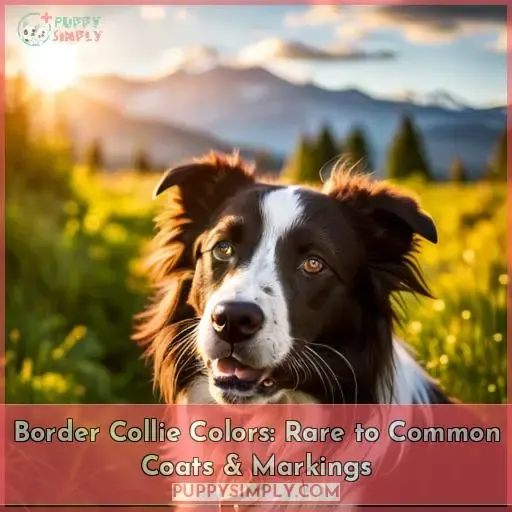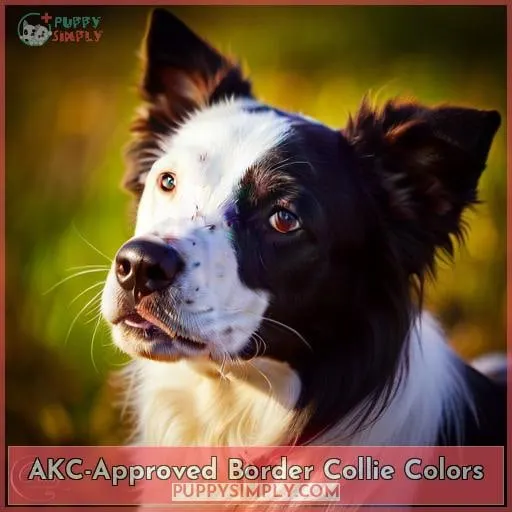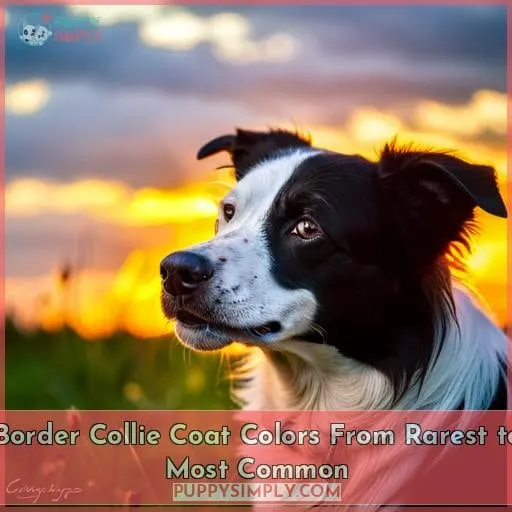This site is supported by our readers. We may earn a commission, at no cost to you, if you purchase through links.

While the black and white is the most common, there are also chocolate, red, and blue variations. Intriguing, isn’t it? Keep reading to explore the full depth of the border collie color palette and learn how these striking hues and patterns develop.
Table Of Contents
Key Takeaways
- AKC recognizes 17 standard and non-standard colors for Border Collies.
- The most common coat colors are Bicolor and Tricolor.
- Merle patterns include Blue, Red, and rare Slate.
- Border Collies can have a variety of coat colors including Black+White, Chocolate+White, Blue+White, and Red Merle.
AKC-Approved Border Collie Colors
You can choose from a wide variety of colors and patterns for your border collie, as the BCSA and AKC recognize all hues. The breed has a double-layered coat that may be smooth/short or rough/medium in texture.
Bicolor and tricolor are the most common color combinations, with black + white, chocolate + white, blue + white, and red being popular options. Blue merle is created when the merle pattern breaks up the base color, while red merles have one parent carrying two copies of this gene variant.
Chocolate tri-color dogs feature both tri-color genetics coupled with genes for brown fur pigment.
Rare colors include lilac, which result from combining chocolate plus dilute genes.
Puppy coloring may change slightly as they mature, so it’s important to focus on health when breeding regulations require specific markings for show requirements, no matter what hue you select!
Border Collie Coat Colors From Rarest to Most Common
When it comes to Border Collie coat colors, there is a wide range of shades and patterns available. From the rarest white coats to the most common lilac and blue varieties, all the way up to brindle markings and slate merle coloring – you can find something that suits your tastes! Keep in mind, however, that health should come first when selecting a pup; no matter what color or pattern you choose.
White
White is a popular option among Border Collies, often appearing in bicolor and tricolor combinations to create beautiful patterns. White patches may be passed down through heredity and genetics or appear as a result of crossing specific colors.
Grooming their weatherproofing coats regularly helps keep these white Border Collies looking neat and clean! Pure white coats are rarer than other shades but can occur if both parents carry the right combination of genes for this color.
Lilac
Lilac is the result of an exquisite genetic basis and a combination of chocolate and dilute genes. This captivating hue is achieved through selective breeding for show standards, as well as variations in color dilution.
The lilac Border Collie stands out with its striking sable merle coloring that has tan markings along with white markings for a brindle effect.
Blue
Blue is one of the most common Border Collie colors, with nearly 70% of all BCs having some shade of blue in their coat. Blue coats are typically double-layered and can range from smooth/short to rough/medium.
The color palette includes blue merles, regular blues (no dilution), red merles, as well as combinations such as white with a touch of blue or black marking on the face or body.
Colors like this often come down to luck when it comes to breeding, but each pup’s individual personality makes them special regardless! All in all, while eye-catching colors may be appealing at first glance, you should always research breeders for health history before making any decisions about your new furry friend!
Brindle
Brindle is a stunning mixture of red/black or yellow/black stripes, making each pup unique and adding to the colorful Border Collie palette. This pattern can be seen in competition at AKC dog shows and requires certain genetics from both parents for this rare combination.
Brindle coats are usually short-haired but require regular grooming as age factors such as hormonal changes may cause matting or tangling, which could lead to health risks if not addressed quickly.
Whether you’re looking for some show-stopping color combinations or simply want your pup to stand out from the pack, brindle Border Collies will never disappoint!
Slate Merle
Slate merle is a stunningly unique color that stands out from the crowd, with only one in 1,000 Border Collies having this rare combination of genes. The slate merle pattern creates dark tips and lighter areas on their coat due to the double-merle gene mutation.
This color variation can also be seen with sable or red merles, but they are even more difficult to find due to breeder selection practices. The coat texture varies depending on which parent carries the dominant gene while still maintaining both smooth/short and rough/medium lengths for optimal performance during herding activities.
With great genetic diversity available within its breed pedigree, it’s no wonder why Border Collie fans often search for these rare colors!
The Border Collie’s Fur Color, Markings, and Pattern
Are you curious about the range of colors and patterns that can be found in a Border Collie’s fur? The most common color combinations are black and white, chocolate and white, blue and white, and red and blue merle.
These stunning dogs have double-layered coats with smooth or medium lengths depending on their age.
Black & White Border Collie
You can opt for the classic black and white Border Collie, a timeless combination of two distinct colors that will stand out in any crowd. Genetics largely dictate the final color outcome, but environmental factors like socialization also play a role.
Eye color usually matches one of its base coat’s hues, while white markings are common on both black or merle patterns.
Chocolate & White Border Collie
You’ll love the unique chocolate and white pattern of a Border Collie, with eye-catching patches that look like they’ve been painted on. The BCSA and AKC breed standards recognize this color combo as part of their official classification.
To ensure your pup stays healthy, it’s important to consider potential health concerns when breeding for certain colors or patterns. Grooming practices, such as regular coat care, are also essential for maintaining its vibrant appearance over time.
As one of the rarer coat colors due to recessive genes in both the chocolate gene plus dilute genes present in some dogs, these pups have darker patches around their eyes and muzzle against a lighter-colored body.
Blue & White Border Collie
Discover the beautiful blue and white pattern of a Border Collie, with patches that look like pieces of a puzzle. This color combo is recognized by both AKC and BCSA breed standards as part of their official classification.
Health testing, genetics research, and temperament evaluation are important when breeding for certain colors or patterns to maintain its vibrant appearance over time. Blue merle dogs have dark markings around the eyes and muzzle against a lighter body, while red merle pups have more scattered red coloring across light coats.
All these variations make this coat palette truly unique – so don’t forget to focus on health and temperament before rare colors!
Red Border Collie
Witness the stunning beauty of a red Border Collie, with its fiery orange coat and classic black markings – an awe-inspiring sight! This breed is known for their intelligent breeding traits and double-layered coats that come in both smooth/short or rough/medium lengths.
Grooming needs are minimal due to their natural oils, and coat care should focus on brushing regularly, as well as occasional baths.
The genetic diversity of this pup’s fur allows it to have white markings against a base color of red or merle patterns breaking up the hue. Red merles have more scattered patches across light coats, while blue merles will contain dark eyes and muzzles against lighter bodies.
Blue Merle Border Collie
Admire the awe-inspiring beauty of a blue merle Border Collie, with its striking contrast between dark orange-brown patches and a light coat. The breeding conformation has been carefully developed to ensure health in these puppies, while their coats come in various colors that mix together harmoniously.
Puppy care should focus on regular brushing and occasional bathing, as well as research into genetics for future owners who wish to know more about their pup’s heritage.
With proper care, any owner can enjoy the presence of this majestic creature without worrying about color variations.
Border Collie Puppy Colors Changing
As your pup matures, you’ll witness its coat transform like a kaleidoscope of colors, with changes so drastic it’s almost unbelievable! Genetics play an important role in the color and pattern of a Border Collie’s fur.
Commonly seen are bicolor or tricolor coats—black and white, chocolate and white, blue merle or red merle—with the latter two having their base color broken up by patches from the merle gene.
Rarer but still beautiful are lilac (chocolate plus dilute genes), sable (tan/cream with dark tips), and brindle (alternating red/black or yellow/black stripes).
Eye color may also change over time; some puppies have bright blues that later turn brown as they age.
Grooming needs will differ depending on if your pup has a smooth short coat versus rough medium one; regular brushing is essential for both to remove debris from their double-layered fur.
Red Merles can be particularly prone to sunburns due to their pale skin tones, while White Ticked dogs can require extra care when it comes to keeping them looking clean since dirt often sticks more easily in between each hair strand against their lighter colored coats than darker ones like Sables or Brindles, which offer better camouflage protection against dust accumulation!
Regardless of breed type, though, all BCs need proper nutrition along with adequate exercise for optimal health effects, which should always be prioritized over any rare coat colors alone, no matter how appealing they may appear at first glance!
Are Rare Coat Colors Worth It?
With their ever-changing coat like a kaleidoscope of colors, Border Collies are an intriguing breed that can keep you on your toes – but is it worth the pursuit of rare hues? While some people may be drawn to rare colors such as lilac or sable merle, adopting a pup with these coats comes with its own set of risks.
It’s important to do thorough research before getting any new pet—especially when dealing with color genetics. Red Merles in particular carry sunburn risks due to their pale skin tone and White Ticked dogs require extra grooming attention since dirt tends to stick more easily in between each hair strand against lighter colored coats than darker ones like Sables or Brindles which offer better camouflage protection against dust accumulation.
Health should always come first over any fancy fur pattern; make sure that you are committed for life and able provide the proper nutrition plus adequate exercise for optimal effects before making this significant decision! Ultimately, all BCs have beautiful coats no matter what shade they may be so focus on finding one whose temperament best suits your lifestyle needs regardless if it has striking seal eyes or deep blue merles instead!
Frequently Asked Questions (FAQs)
What grooming needs do Border Collies have?
Groom your Border Collie regularly for the best results. Their double-layered coat requires brushing to keep it healthy and prevent matting. Trim the fur around their face, feet, and undercoat as needed to maintain a neat look.
Are Border Collies hypoallergenic?
No, Border Collies are not hypoallergenic. They have a double-layered coat that requires regular brushing and grooming to keep it healthy and clean.
What health concerns should prospective owners be aware of when looking for a Border Collie puppy?
Prospective owners should research Border Collie health concerns before purchasing a puppy. One interesting statistic is that 80% of dogs over 5 years old suffer from at least one chronic condition.
What is the average life expectancy of a Border Collie?
The average life expectancy of a Border Collie is around 12 to 15 years. With proper care and nutrition, they can enjoy an active and healthy life full of energy.
How often should Border Collie puppies be taken to the vet?
Take your Border Collie puppy to the vet regularly for checkups. Vaccinations, tests, and preventive care can help keep them healthy – like filling up a car with gas! A metaphor of ‘fuel’ will make sure you get where you need to go: providing your puppy with essential medical maintenance.
Conclusion
No two Border Collies are alike. With a palette of colors, markings, and patterns, the possibilities can seem endless. From rare white coats to common black and white, the Border Collie has it all. It’s important to remember, however, that these pups were bred for their abilities, not their color.
Purchasing one that’s healthy and has a good temperament should always be the top priority.
Still, it’s hard to deny the beauty of a rare Border Collie coat. Like a ray of sunshine, the lilac coat can be a bright spot in one’s life.











